Ballistics
Lobbing Explosives
- Support more than one tower type.
- Create a mortar tower.
- Calculate parabolic trajectories.
- Launch explosive shells.
This is the fourth installment of a tutorial series about creating a simple tower defense game. It adds a mortar tower that launches shells that detonate on impact.
This tutorial is made with Unity 2018.4.4f1.

Tower Types
Laser aren't the only kind of weaponry that we could mount on a tower. In this tutorial we'll add a second tower type that lobs shells that explode on impact and damage all nearby enemies. To make that possible we have to support more than one type of tower.
Abstract Tower
Acquiring and tracking a target is functionality that any tower could use, so we'll put that in an abstract base class for towers. We'll simply use Tower for that, but first duplicate it for later use as the concrete LaserTower. Then remove all code specific to the laser from Tower. A tower might not track a specific target, so also remove the target field and change AcquireTarget to use an output parameter and TrackTarget to use a reference parameter. Then remove the target visualization from OnDrawGizmosSelected, but keep the targeting range because that applies to all towers.
using UnityEngine;
public abstract class Tower : GameTileContent {
const int enemyLayerMask = 1 << 9;
static Collider[] targetsBuffer = new Collider[100];
[SerializeField, Range(1.5f, 10.5f)]
protected float targetingRange = 1.5f;
//…
protected bool AcquireTarget (out TargetPoint target) {
…
}
protected bool TrackTarget (ref TargetPoint target) {
…
}
void OnDrawGizmosSelected () {
Gizmos.color = Color.yellow;
Vector3 position = transform.localPosition;
position.y += 0.01f;
Gizmos.DrawWireSphere(position, targetingRange);
//if (target != null) {
// Gizmos.DrawLine(position, target.Position);
//}
}
}
Adjust the duplicate class so it becomes LaserTower that extends Tower and uses the functionality of its base class, getting rid of the duplicate code.
using UnityEngine;
public class LaserTower : Tower {
//…
[SerializeField, Range(1f, 100f)]
float damagePerSecond = 10f;
[SerializeField]
Transform turret = default, laserBeam = default;
TargetPoint target;
Vector3 laserBeamScale;
void Awake () {
laserBeamScale = laserBeam.localScale;
}
public override void GameUpdate () {
if (TrackTarget(ref target) || AcquireTarget(out target)) {
Shoot();
}
else {
laserBeam.localScale = Vector3.zero;
}
}
void Shoot () {
…
}
//…
}
Then update the laser tower prefab so it uses the new specific component.
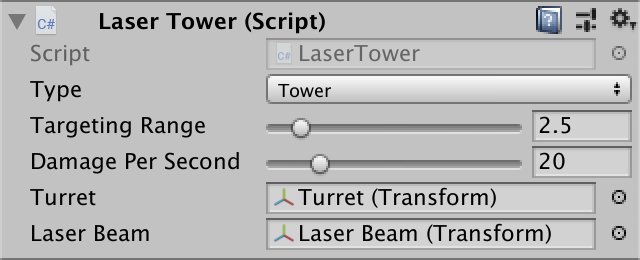
Fabricating a Specific Tower Type
To make it possible to select which kind of tower gets placed on the board we will introduce a TowerType enumeration, just like GameTileContentType. We'll support the existing laser type and the mortar type that we'll create later.
public enum TowerType {
Laser, Mortar
}
As we'll create a class for each tower type, add an abstract getter property to Tower to indicate its type. This works the same as the shape behavior type from the Object Management series.
public abstract TowerType TowerType€ { get; }
Override it in LaserTower to have it return the correct type.
public override TowerType TowerType€ => TowerType.Laser;
Next, adjust GameTileContentFactory so it can produce a tower of a desired type. We'll do that with a tower array and adding an alternative public Get method that has a TowerType parameter. We can use assertions to verify that the array is set up correctly. The other public Get method is now only for non-tower tile content.
[SerializeField]
Tower[] towerPrefabs = default;
public GameTileContent Get (GameTileContentType type) {
switch (type) {
…
//case GameTileContentType.Tower: return Get(towerPrefab);
}
Debug.Assert(false, "Unsupported non-tower type: " + type);
return null;
}
public GameTileContent Get (TowerType type) {
Debug.Assert((int)type < towerPrefabs.Length, "Unsupported tower type!");
Tower prefab = towerPrefabs[(int)type];
Debug.Assert(type == prefab.TowerType€, "Tower prefab at wrong index!");
return Get(prefab);
}
It makes sense to return the most specific type, so ideally the new Get method's return type should be Tower. But the private Get method used to instantiate the prefab returns GameTileContent. We could either perform a cast here, or make the private Get method generic. Let's do the latter.
public Tower Get (TowerType type) {
…
}
T Get<T> (T prefab) where T : GameTileContent {
T instance = CreateGameObjectInstance(prefab);
instance.OriginFactory = this;
return instance;
}
As we only have the laser tower yet, make it the single element of the factory's tower array.

Spawning Specific Tower Types
To spawn a specific kind of tower, adjust GameBoard.ToggleTower so it requires a TowerType parameter and passes it on to the factory.
public void ToggleTower (GameTile tile, TowerType towerType) {
if (tile.Content.Type == GameTileContentType.Tower€) {
…
}
else if (tile.Content.Type == GameTileContentType.Empty) {
tile.Content = contentFactory.Get(towerType);
…
}
else if (tile.Content.Type == GameTileContentType.Wall) {
tile.Content = contentFactory.Get(towerType);
updatingContent.Add(tile.Content);
}
}
That introduces a new possibility: a tower gets toggled while one already exists, but they are of different types. Currently that just removes the existing tower, but it makes more sense that it gets replaced with the new type, so let's do that instead. As that keeps the tile occupied pathfinding isn't needed when this happens.
if (tile.Content.Type == GameTileContentType.Tower€) {
updatingContent.Remove(tile.Content);
if (((Tower)tile.Content).TowerType€ == towerType) {
tile.Content = contentFactory.Get(GameTileContentType.Empty);
FindPaths();
}
else {
tile.Content = contentFactory.Get(towerType);
updatingContent.Add(tile.Content);
}
}
Now Game has to keep track of what kind of tower should be toggled. We'll simply associate each tower type with a number. The laser tower is 1, which is also the default, while the mortar tower is 2. Pressing the number keys will select the corresponding tower type.
TowerType selectedTowerType;
…
void Update () {
…
if (Input.GetKeyDown(KeyCode.G)) {
board.ShowGrid = !board.ShowGrid;
}
if (Input.GetKeyDown(KeyCode.Alpha1)) {
selectedTowerType = TowerType.Laser;
}
else if (Input.GetKeyDown(KeyCode.Alpha2)) {
selectedTowerType = TowerType.Mortar;
}
…
}
…
void HandleTouch () {
GameTile tile = board.GetTile(TouchRay);
if (tile != null) {
if (Input.GetKey(KeyCode.LeftShift)) {
board.ToggleTower(tile, selectedTowerType);
}
else {
board.ToggleWall(tile);
}
}
}
Mortar Tower
Placing a mortar tower currently fails, because we don't have a prefab for it yet. Begin by creating a minimal MortarTower type . Mortars have a fire rate, for which we can use a shots-per-second configuration field. Besides that we need a reference to the mortar so that we can aim it.
using UnityEngine;
public class MortarTower : Tower {
[SerializeField, Range(0.5f, 2f)]
float shotsPerSecond = 1f;
[SerializeField]
Transform mortar = default;
public override TowerType TowerType€ => TowerType.Mortar;
}
Next, create a prefab for the mortar tower. You can do that by duplicating the laser tower prefab and replacing its tower component. Then get rid of the tower and laser beam objects. Rename the turret to mortar, move it down so it sits on top of the base, give it a slightly gray color, and hook it up. Again, we can keep the mortar's collider fixed, in this case by using a separate object with just the collider superimposed on the mortar's default orientation. I set its range to 3.5 and shots-per-second to 1.
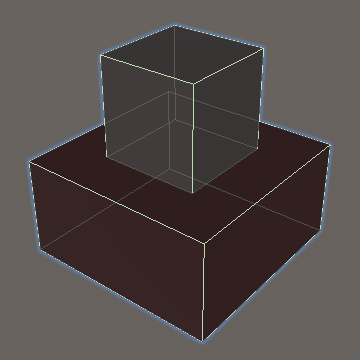

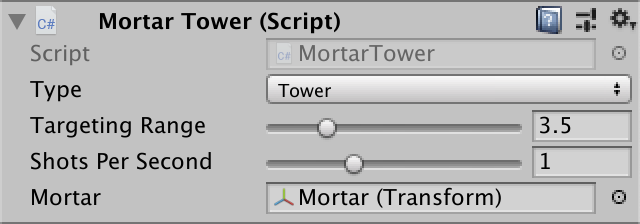
Add the mortar prefab to the factory's array, so it becomes possible to place mortar towers on the board. At this point they don't do anything yet though.

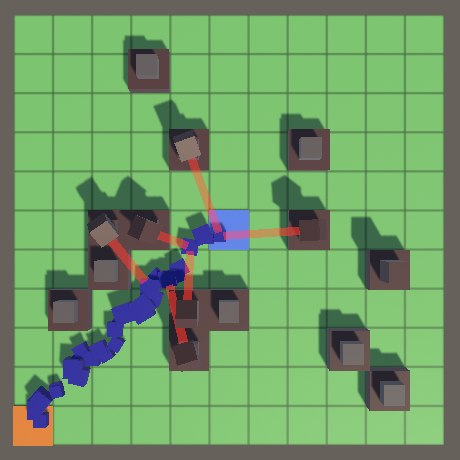
Calculating Trajectories
A mortar works by firing a projectile at an angle, so it gets lobbed over obstacles and hits its target from above. Typically, shells are used that detonate on impact or while they are still above their target. To keep it simple we'll always aim at the ground, so shells will detonate once their elevation has been reduced to zero.
Aiming Horizontally
To aim a mortar you have to both point it toward the target horizontally and then adjust its vertical orientation so the shell lands at the correct distance. We begin with the first step, initially using fixed relative points instead of moving targets to make it easy to verify that our calculations are correct.
Add a GameUpdate method to MortarTower that always invokes a Launch method. Instead of launching an actual shell, for now we'll visualize the math involved. The launch point is the mortar's world position, which is a little above the ground. Place the target point three units further along the X axis, and set its Y component to zero as we always aim at the ground. Then show the points by drawing a yellow line between them, by invoking Debug.DrawLine. The line will be visible in the scene view for one frame, which is enough because we draw a new line every frame.
public override void GameUpdate () {
Launch();
}
public void Launch () {
Vector3 launchPoint = mortar.position;
Vector3 targetPoint = new Vector3(launchPoint.x + 3f, 0f, launchPoint.z);
Debug.DrawLine(launchPoint, targetPoint, Color.yellow);
}
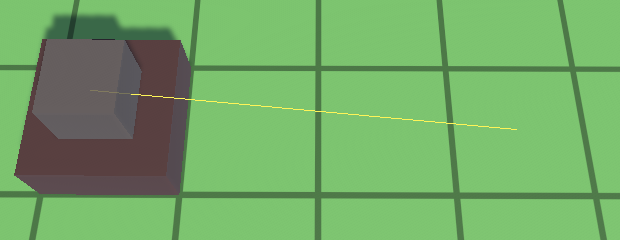
Using this line we can define a right triangle. Its top point sits at the mortar's position. Relative to the mortar that's `[[0],[0]]`. The point below at the base of the tower is `[[0],[y]]` and the point at the target is `[[x],[y]]`, where `x` is 3 and `y` is negative mortar's vertical position. We have to keep track of these two values.
Vector3 launchPoint = mortar.position; Vector3 targetPoint = new Vector3(launchPoint.x + 3f, 0f, launchPoint.z); float x = 3f; float y = -launchPoint.y;

In general the target can be anywhere within range, so the Z dimension also plays a role. However, the targeting triangle remains 2D, it just gets rotated around the Y axis. To illustrate this we'll add a relative offset vector parameter to Launch and invoke it with four XZ offsets: `[[3],[0]]`, `[[0],[1]]`,`[[1],[1]]`, and `[[3],[1]]`. The the target point becomes equal to the launch point plus that offset, with its Y coordinate then set to zero.
public override void GameUpdate () {
Launch(new Vector3(3f, 0f, 0f));
Launch(new Vector3(0f, 0f, 1f));
Launch(new Vector3(1f, 0f, 1f));
Launch(new Vector3(3f, 0f, 1f));
}
public void Launch (Vector3 offset) {
Vector3 launchPoint = mortar.position;
Vector3 targetPoint = launchPoint + offset;
targetPoint.y = 0f;
…
}
Now the `x` of the targeting triangle is equal to the length of the 2D vector pointing from the base of the tower to the target point. Normalizing that vector also gives us an XZ direction vector that we can use to align the triangle. We can show that by drawing the bottom of the triangle with a white line, derived from the direction and `x`.
Vector2 dir; dir.x = targetPoint.x - launchPoint.x; dir.y = targetPoint.z - launchPoint.z; float x = dir.magnitude; float y = -launchPoint.y; dir /= x; Debug.DrawLine(launchPoint, targetPoint, Color.yellow); Debug.DrawLine( new Vector3(launchPoint.x, 0.01f, launchPoint.z), new Vector3( launchPoint.x + dir.x * x, 0.01f, launchPoint.z + dir.y * x ), Color.white );
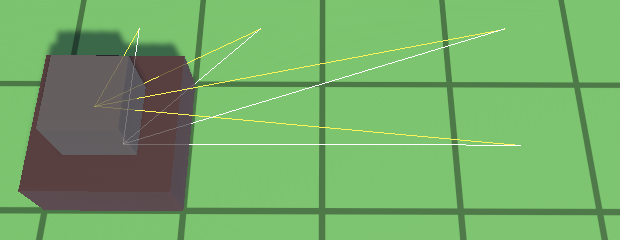
Launch Angle
The next step is to figure out the angle at which the shell must be launched. We have to derive that from the physics of the shell's trajectory. We won't consider drag, wind, or any other kind of interference, only the launch velocity `v` and gravity `g = 9.81`.
The displacement `d` of the shell is aligned with the targeting triangle and can be described with two components. The horizontal displacement is straightforward `d_x=v_xt` where `t` is the time since launch. The vertical component is similar but also subject to negative acceleration due to gravity, so `d_y=v_yt-(g t^2)/2`.
We launch the shells with a fixed speed `s` that is independent of the launch angle `theta` (theta). So `v_x=scostheta` and `v_y=ssintheta`.
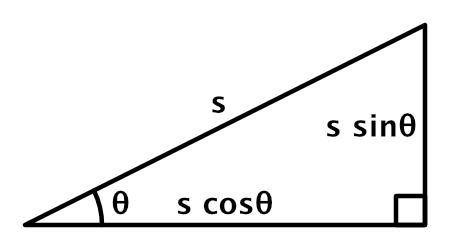
Substituting, we arrive at `d_x=stcostheta` and `d_y=stsintheta-(g t^2)/2`.
We launch the shell such that its flight time `t` is exactly long enough that it reaches its target. As the horizontal displacement is simplest, we can express the time using `t=d_x/v_x`. At the destination `d_x=x`, thus `t=x/(scostheta)`. This means that `y=xtantheta-(gx^2)/(2s^2cos^2theta)`.
Using that, we find `tantheta=(s^2+-sqrt(s^4-g(gx^2+2ys^2)))/(gx)`.
There are two possible launch angles because it's possible to aim either low or high. A low trajectory is faster as it's closer to a straight line to the target. But a high trajectory is more visually interesting so we'll go for that. This means that we only need to use the largest solution, `tantheta=(s^2+sqrt(s^4-g(gx^2+2ys^2)))/(gx)`. Calculate that and also `costheta` and `sintheta`, because we need those to derive the launch velocity vector. We have to convert `tantheta` to a radian angle for that, via Mathf.Atan. Let's initially use a fixed launch speed of 5.
float x = dir.magnitude; float y = -launchPoint.y; dir /= x; float g = 9.81f; float s = 5f; float s2 = s * s; float r = s2 * s2 - g * (g * x * x + 2f * y * s2); float tanTheta = (s2 + Mathf.Sqrt(r)) / (g * x); float cosTheta = Mathf.Cos(Mathf.Atan(tanTheta)); float sinTheta = cosTheta * tanTheta;
Let's visualize the trajectory by drawing ten blue line segments covering the first second of the flight.
float sinTheta = cosTheta * tanTheta;
Vector3 prev = launchPoint, next;
for (int i = 1; i <= 10; i++) {
float t = i / 10f;
float dx = s * cosTheta * t;
float dy = s * sinTheta * t - 0.5f * g * t * t;
next = launchPoint + new Vector3(dir.x * dx, dy, dir.y * dx);
Debug.DrawLine(prev, next, Color.blue);
prev = next;
}
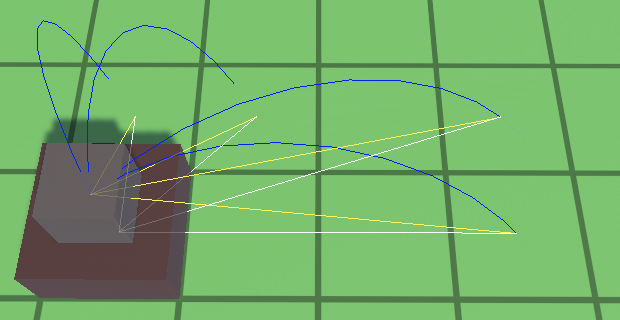
The two farthest points can be reached in less than a second, so we see their entire trajectories and the lines continue a bit below the ground. The other two points require larger launch angles, which leads to longer trajectories that take more than a second to traverse.
Launch Speed
If we want to reach the nearest two points within a second then we'd have to reduce the launch speed. Let's set it to 4.
float s = 4f;
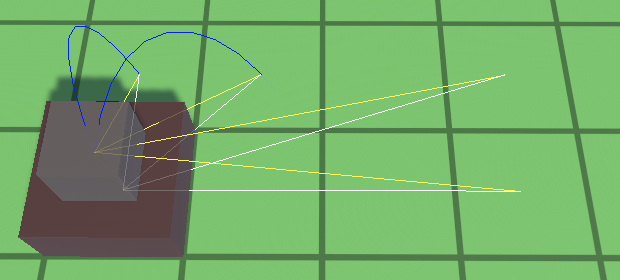
Their trajectories are now complete, but the other two have disappeared. That happened because the launch speed is now insufficient to reach those points. There are no solutions for `tantheta` in those cases, which means that we end up with the square root of a negative number, leading to not-a-number values which cause our lines to disappear. We can detect that by checking whether `r` is negative.
float r = s2 * s2 - g * (g * x * x + 2f * y * s2); Debug.Assert(r >= 0f, "Launch velocity insufficient for range!");
We can avoid this situation by using a high enough launch speed. But if it becomes too high then nearby targets would require very high trajectories and flight times to hit, so we want to keep the speed as low as possible. Our launch speed should be just enough to hit a target at maximum range.
At maximum range, `r=0` so there is only one solution for `tantheta`, which is a low trajectory. This means that we know the required launch speed `s=sqrt(g(y+sqrt(x^2+y^2)))`.
We only need to figure out the required speed when the mortar awakens, or when we adjust its range while in play mode. So keep track of it with a field and calculate it in Awake and OnValidate.
float launchSpeed;
void Awake () {
OnValidate();
}
void OnValidate () {
float x = targetingRange;
float y = -mortar.position.y;
launchSpeed = Mathf.Sqrt(9.81f * (y + Mathf.Sqrt(x * x + y * y)));
}
However, due to floating-point precision a target very close to the maximum range might fail. So we should add a tiny amount to the range when calculating the required speed. Also, the enemy collider radius effectively extends the maximum tower range. We set it to 0.125 subject to at most doubling due to enemy scale, so increase the effective range by a further 0.25, to something like 0.25001.
float x = targetingRange + 0.25001f;
Finally, use the derived launch speed in Launch.
float s = launchSpeed;
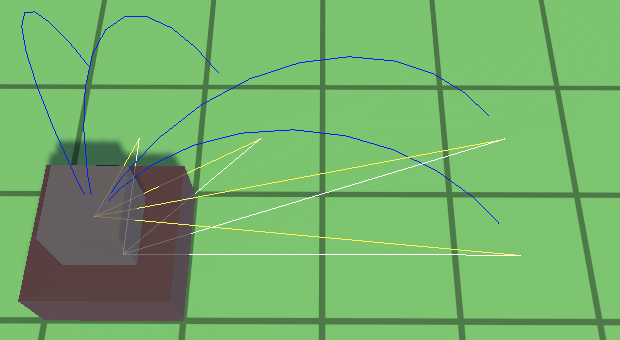
Barrage
Now that our trajectory calculation is correct we can get rid of the relative test targets. Instead, Launch should be provided with a target point.
public void Launch (TargetPoint target) {
Vector3 launchPoint = mortar.position;
Vector3 targetPoint = target.Position;
targetPoint.y = 0f;
…
}
And we're not firing every frame. Keep track of the launch progress just like the spawn progress for enemies and acquire a random target when it's time to launch in GameUpdate. But there might be no target available at that time. In that case we keep the launch progress, but don't let it accumulate further. In fact, to prevent an infinite loop we should set it to slightly less than 1.
float launchProgress;
…
public override void GameUpdate () {
launchProgress += shotsPerSecond * Time.deltaTime;
while (launchProgress >= 1f) {
if (AcquireTarget(out TargetPoint target)) {
Launch(target);
launchProgress -= 1f;
}
else {
launchProgress = 0.999f;
}
}
}
We don't track targets in between launches, but we have to properly align the mortar when firing. We can use the horizontal launch direction vector to horizontally rotate the mortar by using Quaternion.LookRotation. We also have to incorporate the launch angle, by using `tantheta` for the Y component of the direction vector. That works because the horizontal direction has a length of 1, thus `tantheta=sintheta`.
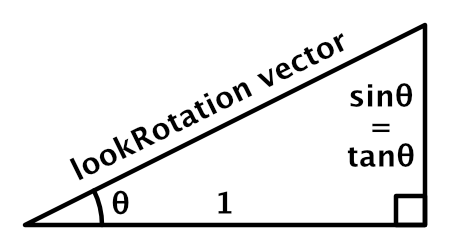
float tanTheta = (s2 + Mathf.Sqrt(r)) / (g * x); float cosTheta = Mathf.Cos(Mathf.Atan(tanTheta)); float sinTheta = cosTheta * tanTheta; mortar.localRotation = Quaternion.LookRotation(new Vector3(dir.x, tanTheta, dir.y));
To still be able to see the launch trajectories, we can add a parameter to Debug.DrawLine to give them a duration.
Vector3 prev = launchPoint, next;
for (int i = 1; i <= 10; i++) {
…
Debug.DrawLine(prev, next, Color.blue, 1f);
prev = next;
}
Debug.DrawLine(launchPoint, targetPoint, Color.yellow, 1f);
Debug.DrawLine(
…
Color.white, 1f
);
Shells
The point of calculating trajectories is that we now know how to launch shells. The next step is to create and launch them.
We need a factory to create instances of shell objects. Once in the air, shells exist on their own and no longer depend on the mortar that launched them. So mortar tower's shouldn't manage them and the game tile content factory also isn't a good fit. Let's create a new factory for everything related to weaponry, naming it the war factory. First, create an abstract Then create a concrete Followed by Create a prefab for the shell. I simply used a cube with uniform scale 0.25 and a dark material, plus the To move the shells we'll have to update them. We can use the same approach that Then refactor Make And do the same for From now on The last step to get updating shells is to somehow add them to the collection of non-enemies. Let's do that by having Once a shell has been spawned, it must fly along its trajectory until it reaches its target. To make that possible, add an Now we can spawn a shell in To make To also align the shells with their trajectory we have to make them look along the derivate vector, which is simply the velocity at that time. Now that it is clear that shells are flying as they should, we can remove the trajectory visualization from Also, we have to make sure that shells cease to exist once they've reached their target. As we always aim at the ground, we can do that by checking whether the vertical position has been reduced to zero or less in We're launching shells because they're filled with explosives. When a shell reaches it target, it should detonate and damage all enemies in the blast zone. The blast radius and amount of damage depends on what shells are fired by the mortar, so add configuration options for them to This configuration only matters when the shell explodes, so must be added to To hit enemies in range, the shell must acquire targets. We already have code for that, but it's in Now we can acquire all targets in range—up to the maximum buffer size—and damage them when We can also add a static property to That allows us to simplify Everything works, but it doesn't look very convincing yet. We can approve that by adding a visualization of the explosion blast when a shell detonates. Besides looking more interesting, it also provided useful visual feedback to the player. We'll do this by creating an explosion prefab that's just like the laser beam, except it's a sphere, it's more transparent, and has a brighter color. Give it a new Add the explosion to And add a facade method for it to Now Using unchanging spheres for explosions looks bad. We can improve that by animating their opacity and scale. We could use simple formula for that, but let's use animation curves for both so it's easier to tweak them. Add two I made opacity start and end at zero, smoothly scaling up to 0.3 at the halfway point. I made the scale start at 0.7 and quickly increase and then slowly approach 1. We'll use a material property block to set the material's color, which is black with variable opacity. The scale is now set in Because shells are small and have a relatively high velocity it can be hard to see them. And when looking at a screenshot of a single frame the trajectories aren't clear at all. We could make that more obvious by adding a trail effect to the shells. That isn't realistic for normal shells, but we can declare that they are tracer shells. Such projectiles are specifically made to leave a bright trail for the purpose of making their trajectories visible. There are various ways to create trails, but we'll use a very simple approach here. We repurpose explosions, having Spawn an explosion at the end up The next tutorial is Scenarios.War Factory
WarEntity with an appropriate OriginFactory property and Recycle method.using UnityEngine;
public abstract class WarEntity : MonoBehaviour {
WarFactory originFactory;
public WarFactory OriginFactory {
get => originFactory;
set {
Debug.Assert(originFactory == null, "Redefined origin factory!");
originFactory = value;
}
}
public void Recycle () {
originFactory.Reclaim(this);
}
}
Shell war entity of our shells.using UnityEngine;
public class Shell : WarEntity { }
WarFactory itself, which can deliver a shell via a public getter property.using UnityEngine;
[CreateAssetMenu]
public class WarFactory : GameObjectFactory {
[SerializeField]
Shell shellPrefab = default;
public Shell Shell€ => Get(shellPrefab);
T Get<T> (T prefab) where T : WarEntity {
T instance = CreateGameObjectInstance(prefab);
instance.OriginFactory = this;
return instance;
}
public void Reclaim (WarEntity entity) {
Debug.Assert(entity.OriginFactory == this, "Wrong factory reclaimed!");
Destroy(entity.gameObject);
}
}
Shell component. Then create the war factory asset and assign the shell prefab to it.
Game Behavior
Game uses to update the enemies. In fact, we can make this approach generic by introducing an abstract GameBehavior component that extends MonoBehaviour and adds a virtual GameUpdate method.using UnityEngine;
public abstract class GameBehavior : MonoBehaviour {
public virtual bool GameUpdate () => true;
}
EnemyCollection, turning it into GameBehaviorCollection.public class GameBehaviorCollection {
List<GameBehavior> behaviors = new List<GameBehavior>();
public void Add (GameBehavior behavior) {
behaviors.Add(behavior);
}
public void GameUpdate () {
for (int i = 0; i < behaviors.Count; i++) {
if (!behaviors[i].GameUpdate()) {
int lastIndex = behaviors.Count - 1;
behaviors[i] = behaviors[lastIndex];
behaviors.RemoveAt(lastIndex);
i -= 1;
}
}
}
}
WarEntity extend GameBehavior instead of MonoBehavior.public abstract class WarEntity : GameBehavior { … }
Enemy, now overriding the GameUpdate method.public class Enemy : GameBehavior {
…
public override bool GameUpdate () { … }
…
}
Game has to keep track of two collections, one for enemies and another for non-enemies. The non-enemies should be updated after everything else. GameBehaviorCollection enemies = new GameBehaviorCollection();
GameBehaviorCollection nonEnemies = new GameBehaviorCollection();
…
void Update () {
…
enemies.GameUpdate();
Physics.SyncTransforms();
board.GameUpdate();
nonEnemies.GameUpdate();
}
Game function as a static facade for the war factory, so shells can be spawned by invoking Game.SpawnShell(). To make that work Game needs a reference to the war factory and has to keep track of its own instance. [SerializeField]
WarFactory warFactory = default;
…
static Game instance;
public static Shell SpawnShell () {
Shell shell = instance.warFactory.Shell€;
instance.nonEnemies.Add(shell);
return shell;
}
void OnEnable () {
instance = this;
}
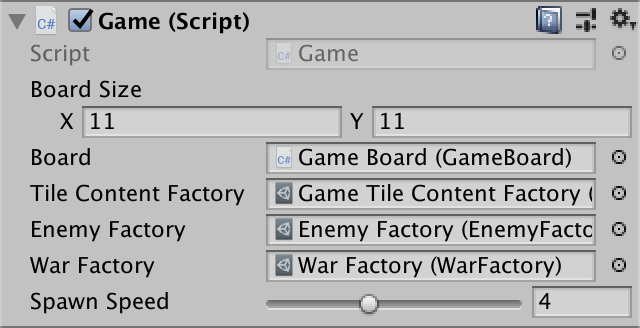
Launching the Shell
Initialize method to Shell and use it to set up its launch point, target point, and launch velocity. Vector3 launchPoint, targetPoint, launchVelocity;
public void Initialize (
Vector3 launchPoint, Vector3 targetPoint, Vector3 launchVelocity
) {
this.launchPoint = launchPoint;
this.targetPoint = targetPoint;
this.launchVelocity = launchVelocity;
}
MortarTower.Launch and send it on its way. mortar.localRotation =
Quaternion.LookRotation(new Vector3(dir.x, tanTheta, dir.y));
Game.SpawnShell().Initialize(
launchPoint, targetPoint,
new Vector3(s * cosTheta * dir.x, s * sinTheta, s * cosTheta * dir.y)
);
Shell Motion
Shell move we have to keep track of its age, which is the time since launch. We can then calculate its position in GameUpdate. We always do this relative to its launch point, so it perfectly follows its trajectory, regardless of the update frequency. float age;
…
public override bool GameUpdate () {
age += Time.deltaTime;
Vector3 p = launchPoint + launchVelocity * age;
p.y -= 0.5f * 9.81f * age * age;
transform.localPosition = p;
return true;
}
public override bool GameUpdate () {
…
Vector3 d = launchVelocity;
d.y -= 9.81f * age;
transform.localRotation = Quaternion.LookRotation(d);
return true;
}
Cleaning Up
MortarTower.Launch. public void Launch (TargetPoint target) {
…
Game.SpawnShell().Initialize(
launchPoint, targetPoint,
new Vector3(s * cosTheta * dir.x, s * sinTheta, s * cosTheta * dir.y)
);
//Vector3 prev = launchPoint, next;
//…
}Shell.GameUpdate. We can do that directly after calculating it, before adjusting the shell's position and rotation. public override bool GameUpdate () {
age += Time.deltaTime;
Vector3 p = launchPoint + launchVelocity * age;
p.y -= 0.5f * 9.81f * age * age;
if (p.y <= 0f) {
OriginFactory.Reclaim(this);
return false;
}
transform.localPosition = p;
…
}
Detonation
MortarTower. [SerializeField, Range(0.5f, 3f)]
float shellBlastRadius = 1f;
[SerializeField, Range(1f, 100f)]
float shellDamage = 10f;

Shell and its Initialize method as well. float age, blastRadius, damage;
public void Initialize (
Vector3 launchPoint, Vector3 targetPoint, Vector3 launchVelocity,
float blastRadius, float damage
) {
…
this.blastRadius = blastRadius;
this.damage = damage;
}
MortarTower only has to pass the data to the shell, after spawning it. Game.SpawnShell().Initialize(
launchPoint, targetPoint,
new Vector3(s * cosTheta * dir.x, s * sinTheta, s * cosTheta * dir.y),
shellBlastRadius, shellDamage
);
Tower. As it is useful for anything that needs a target, copy that functionality to TargetPoint and make it statically available. Add a method to fill the buffer, a property to get the buffered count, and a method to get a buffered target. const int enemyLayerMask = 1 << 9;
static Collider[] buffer = new Collider[100];
public static int BufferedCount { get; private set; }
public static bool FillBuffer (Vector3 position, float range) {
Vector3 top = position;
top.y += 3f;
BufferedCount = Physics.OverlapCapsuleNonAlloc(
position, top, range, buffer, enemyLayerMask
);
return BufferedCount > 0;
}
public static TargetPoint GetBuffered (int index) {
var target = buffer[index].GetComponent<TargetPoint>();
Debug.Assert(target != null, "Targeted non-enemy!", buffer[0]);
return target;
}
Shell detonates. if (p.y <= 0f) {
TargetPoint.FillBuffer(targetPoint, blastRadius);
for (int i = 0; i < TargetPoint.BufferedCount; i++) {
TargetPoint.GetBuffered(i).Enemy€.ApplyDamage(damage);
}
OriginFactory.Reclaim(this);
return false;
}
TargetPoint to conveniently get a random buffered target. public static TargetPoint RandomBuffered =>
GetBuffered(Random.Range(0, BufferedCount));
Tower, as it can now rely on TargetPoint to find a random target.
//const int enemyLayerMask = 1 << 9;
//static Collider[] targetsBuffer = new Collider[100];
…
protected bool AcquireTarget (out TargetPoint target) {
//Vector3 a = transform.localPosition;
//…
//if (hits > 0) {
// …
//}
if (TargetPoint.FillBuffer(transform.localPosition, targetingRange)) {
target = TargetPoint.RandomBuffered;
return true;
}
target = null;
return false;
}Explosions
Explosion war entity component with a configurable duration, with half a second as a reasonable default that is short but long enough to register clearly. Give it an Initialize method to set its position and blast radius. We have to double the radius when setting the scale, because the sphere mesh's radius is 0.5. This is also a good place to apply the damage to all enemies in range, so it should have a parameter for damage as well. Besides that, it needs a GameUpdate method that simply checks whether its time is up.using UnityEngine;
public class Explosion : WarEntity {
[SerializeField, Range(0f, 1f)]
float duration = 0.5f;
float age;
public void Initialize (Vector3 position, float blastRadius, float damage) {
TargetPoint.FillBuffer(position, blastRadius);
for (int i = 0; i < TargetPoint.BufferedCount; i++) {
TargetPoint.GetBuffered(i).Enemy.ApplyDamage(damage);
}
transform.localPosition = position;
transform.localScale = Vector3.one * (2f * blastRadius);
}
public override bool GameUpdate () {
age += Time.deltaTime;
if (age >= duration) {
OriginFactory.Reclaim(this);
return false;
}
return true;
}
}
WarFactory. [SerializeField]
Explosion explosionPrefab = default;
[SerializeField]
Shell shellPrefab = default;
public Explosion Explosion€ => Get(explosionPrefab);
public Shell Shell => Get(shellPrefab);

Game. public static Explosion SpawnExplosion () {
Explosion explosion = instance.warFactory.Explosion€;
instance.nonEnemies.Add(explosion);
return explosion;
}
Shell can spawn and initialize an explosion when it reaches its target. The damage is taken care of by the explosion. if (p.y <= 0f) {
//TargetPoint.FillBuffer(targetPoint, blastRadius);
//for (int i = 0; i < TargetPoint.BufferedCount; i++) {
// TargetPoint.GetBuffered(i).Enemy.ApplyDamage(damage);
//}
Game.SpawnExplosion().Initialize(targetPoint, blastRadius, damage);
OriginFactory.Reclaim(this);
return false;
}Smoother Explosions
AnimationCurve configuration fields to Explosion for that. We'll use the curves to configure the values during the explosion's lifetime, with time 1 representing the end of the explosion, regardless of its actual duration. The same goes for the scale and blast radius. That makes it easier to configure. [SerializeField]
AnimationCurve opacityCurve = default;
[SerializeField]
AnimationCurve scaleCurve = default;

GameUpdate, but we have to keep track of the radius with a field. We can apply the scale doubling once in Initialize. The curve values are found by invoking Evaluate on them with the current age divided by the explosion duration as an argument. static int colorPropertyID = Shader.PropertyToID("_Color");
static MaterialPropertyBlock propertyBlock;
…
float scale;
MeshRenderer meshRenderer;
void Awake () {
meshRenderer = GetComponent<MeshRenderer>();
Debug.Assert(meshRenderer != null, "Explosion without renderer!");
}
public void Initialize (Vector3 position, float blastRadius, float damage) {
…
transform.localPosition = position;
//transform.localScale = Vector3.one * (2f * blastRadius);
scale = 2f * blastRadius;
}
public override bool GameUpdate () {
…
if (propertyBlock == null) {
propertyBlock = new MaterialPropertyBlock();
}
float t = age / duration;
Color c = Color.clear;
c.a = opacityCurve.Evaluate(t);
propertyBlock.SetColor(colorPropertyID, c);
meshRenderer.SetPropertyBlock(propertyBlock);
transform.localScale = Vector3.one * (scale * scaleCurve.Evaluate(t));
return true;
}Tracer Shells
Shell spawn a small one every frame. These are explosions that don't do any damage, so it would be a waste to acquire targets. Have Explosion support such cosmetic use by only applying damage that is larger than zero, then make the damage parameter of Initialize optional. public void Initialize (
Vector3 position, float blastRadius, float damage = 0f
) {
if (damage > 0f) {
TargetPoint.FillBuffer(position, blastRadius);
for (int i = 0; i < TargetPoint.BufferedCount; i++) {
TargetPoint.GetBuffered(i).Enemy.ApplyDamage(damage);
}
}
transform.localPosition = position;
radius = 2f * blastRadius;
}
Shell.GameUpdate with a small radius, say 0.1, to turn them into tracer shells. Note that this approach spawns an explosion per frame, so is frame-rate dependent, which is fine for this simple effect. public override bool GameUpdate () {
…
Game.SpawnExplosion().Initialize(p, 0.1f);
return true;
}